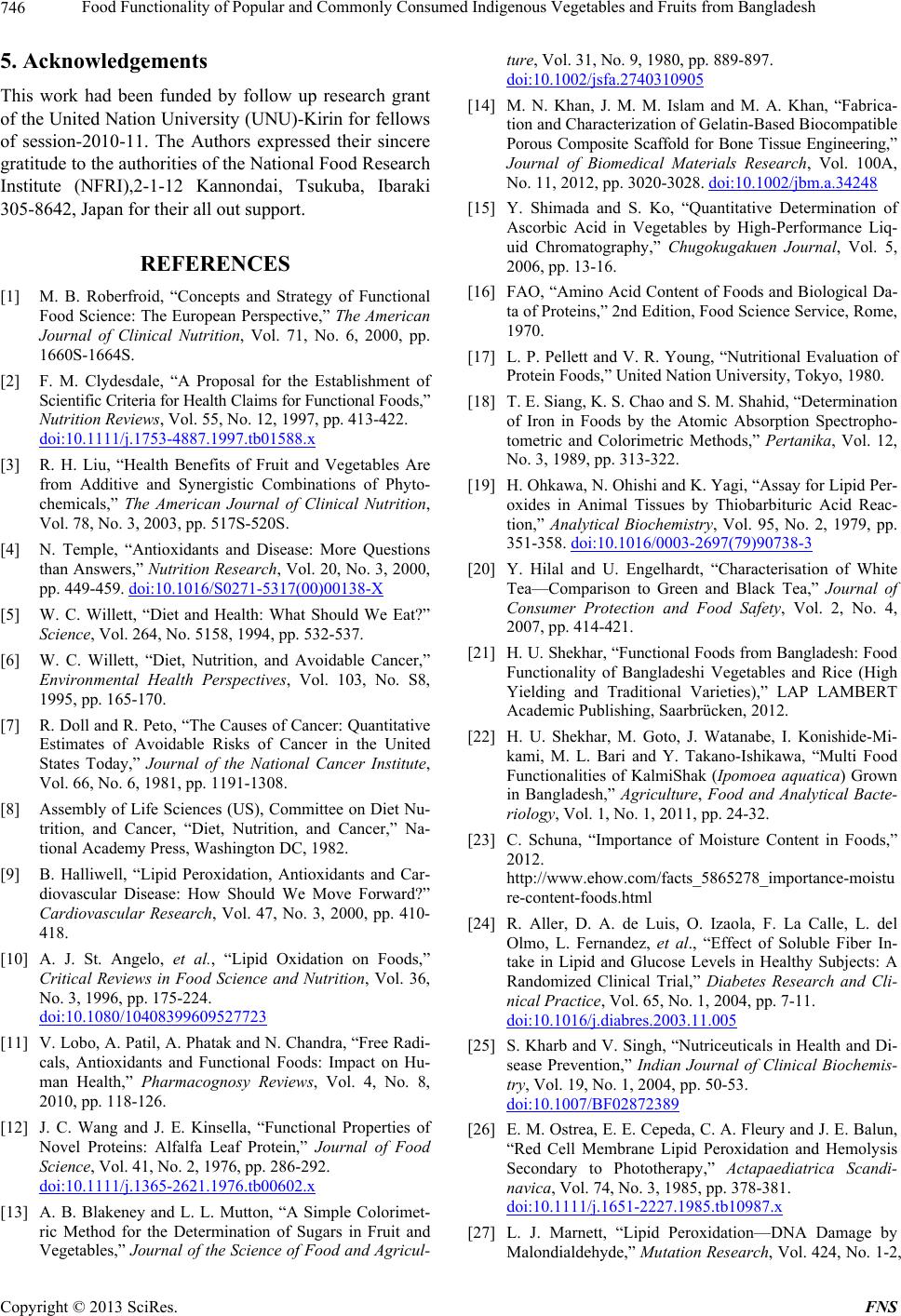
Food Functionality of Popular and Commonly Consumed Indigenous Vegetables and Fruits from Bangladesh
746
5. Acknowledgements
This work had been funded by follow up research grant
of the United Nation University (UNU)-Kirin for fellows
of session-2010-11. The Authors expressed their sincere
gratitude to the authorities of the National Food Research
Institute (NFRI),2-1-12 Kannondai, Tsukuba, Ibaraki
305-8642, Japan for their all out support.
REFERENCES
[1] M. B. Roberfroid, “Concepts and Strategy of Functional
Food Science: The European Perspective,” The American
Journal of Clinical Nutrition, Vol. 71, No. 6, 2000, pp.
1660S-1664S.
[2] F. M. Clydesdale, “A Proposal for the Establishment of
Scientific Criteria for Health Claims for Functional Foods,”
Nutrition Re views, Vol. 55, No. 12, 1997, pp. 413-422.
doi:10.1111/j.1753-4887.1997.tb01588.x
[3] R. H. Liu, “Health Benefits of Fruit and Vegetables Are
from Additive and Synergistic Combinations of Phyto-
chemicals,” The American Journal of Clinical Nutrition,
Vol. 78, No. 3, 2003, pp. 517S-520S.
[4] N. Temple, “Antioxidants and Disease: More Questions
than Answers,” Nutrition Research, Vol. 20, No. 3, 2000,
pp. 449-459. doi:10.1016/S0271-5317(00)00138-X
[5] W. C. Willett, “Diet and Health: What Should We Eat?”
Science, Vol. 264, No. 5158, 1994, pp. 532-537.
[6] W. C. Willett, “Diet, Nutrition, and Avoidable Cancer,”
Environmental Health Perspectives, Vol. 103, No. S8,
1995, pp. 165-170.
[7] R. Doll and R. Peto, “The Causes of Cancer: Quantitative
Estimates of Avoidable Risks of Cancer in the United
States Today,” Journal of the National Cancer Institute,
Vol. 66, No. 6, 1981, pp. 1191-1308.
[8] Assembly of Life Sciences (US), Committee on Diet Nu-
trition, and Cancer, “Diet, Nutrition, and Cancer,” Na-
tional Academy Press, Washington DC, 1982.
[9] B. Halliwell, “Lipid Peroxidation, Antioxidants and Car-
diovascular Disease: How Should We Move Forward?”
Cardiovascular Research, Vol. 47, No. 3, 2000, pp. 410-
418.
[10] A. J. St. Angelo, et al., “Lipid Oxidation on Foods,”
Critical Reviews in Food Science and Nutrition, Vol. 36,
No. 3, 1996, pp. 175-224.
doi:10.1080/10408399609527723
[11] V. Lobo, A. Patil, A. Phatak and N. Chandra, “Free Radi-
cals, Antioxidants and Functional Foods: Impact on Hu-
man Health,” Pharmacognosy Reviews, Vol. 4, No. 8,
2010, pp. 118-126.
[12] J. C. Wang and J. E. Kinsella, “Functional Properties of
Novel Proteins: Alfalfa Leaf Protein,” Journal of Food
Science, Vol. 41, No. 2, 1976, pp. 286-292.
doi:10.1111/j.1365-2621.1976.tb00602.x
[13] A. B. Blakeney and L. L. Mutton, “A Simple Colorimet-
ric Method for the Determination of Sugars in Fruit and
Vegetables,” Journal of the Science of Food and Agricul-
ture, Vol. 31, No. 9, 1980, pp. 889-897.
doi:10.1002/jsfa.2740310905
[14] M. N. Khan, J. M. M. Islam and M. A. Khan, “Fabrica-
tion and Characterization of Gelatin-Based Biocompatible
Porous Composite Scaffold for Bone Tissue Engineering,”
Journal of Biomedical Materials Research, Vol. 100A,
No. 11, 2012, pp. 3020-3028. doi:10.1002/jbm.a.34248
[15] Y. Shimada and S. Ko, “Quantitative Determination of
Ascorbic Acid in Vegetables by High-Performance Liq-
uid Chromatography,” Chugokugakuen Journal, Vol. 5,
2006, pp. 13-16.
[16] FAO, “Amino Acid Content of Foods and Biological Da-
ta of Proteins,” 2nd Edition, Food Science Service, Rome,
1970.
[17] L. P. Pellett and V. R. Young, “Nutritional Evaluation of
Protein Foods,” United Nation University, Tokyo, 1980.
[18] T. E. Siang, K. S. Chao and S. M. Shahid, “Determination
of Iron in Foods by the Atomic Absorption Spectropho-
tometric and Colorimetric Methods,” Pertanika, Vol. 12,
No. 3, 1989, pp. 313-322.
[19] H. Ohkawa, N. Ohishi and K. Yagi, “Assay for Lipid Per-
oxides in Animal Tissues by Thiobarbituric Acid Reac-
tion,” Analytical Biochemistry, Vol. 95, No. 2, 1979, pp.
351-358. doi:10.1016/0003-2697(79)90738-3
[20] Y. Hilal and U. Engelhardt, “Characterisation of White
Tea—Comparison to Green and Black Tea,” Journal of
Consumer Protection and Food Safety, Vol. 2, No. 4,
2007, pp. 414-421.
[21] H. U. Shekhar, “Functional Foods from Bangladesh: Food
Functionality of Bangladeshi Vegetables and Rice (High
Yielding and Traditional Varieties),” LAP LAMBERT
Academic Publishing, Saarbrücken, 2012.
[22] H. U. Shekhar, M. Goto, J. Watanabe, I. Konishide-Mi-
kami, M. L. Bari and Y. Takano-Ishikawa, “Multi Food
Functionalities of KalmiShak (Ipomoea aquatica) Grown
in Bangladesh,” Agriculture, Food and Analytical Bacte-
riology, Vol. 1, No. 1, 2011, pp. 24-32.
[23] C. Schuna, “Importance of Moisture Content in Foods,”
2012.
http://www.ehow.com/facts_5865278_importance-moistu
re-content-foods.html
[24] R. Aller, D. A. de Luis, O. Izaola, F. La Calle, L. del
Olmo, L. Fernandez, et al., “Effect of Soluble Fiber In-
take in Lipid and Glucose Levels in Healthy Subjects: A
Randomized Clinical Trial,” Diabetes Research and Cli-
nical Practice, Vol. 65, No. 1, 2004, pp. 7-11.
doi:10.1016/j.diabres.2003.11.005
[25] S. Kharb and V. Singh, “Nutriceuticals in Health and Di-
sease Prevention,” Indian Journal of Clinical Biochemis-
try, Vol. 19, No. 1, 2004, pp. 50-53.
doi:10.1007/BF02872389
[26] E. M. Ostrea, E. E. Cepeda, C. A. Fleury and J. E. Balun,
“Red Cell Membrane Lipid Peroxidation and Hemolysis
Secondary to Phototherapy,” Actapaediatrica Scandi-
navica, Vol. 74, No. 3, 1985, pp. 378-381.
doi:10.1111/j.1651-2227.1985.tb10987.x
[27] L. J. Marnett, “Lipid Peroxidation—DNA Damage by
Malondialdehyde,” Mutation Research, Vol. 424, No. 1-2,
Copyright © 2013 SciRes. FNS